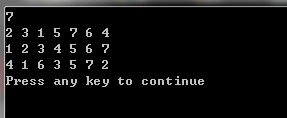二叉树的遍历方式有4种:先序遍历,中序遍历,后序遍历以及层次遍历
根据中序遍历和另外任意一种遍历方式都可以唯一的重建二叉树!
如果没有中序遍历,其余任意两种组合均无法实现二叉树的重建,为什么?
其实原因很简单,先中后说的均为根结点的顺序,那么左子树一定先于右子树遍历到,中序遍历可以根据根结点,将左右子树分开!
那么如何根据中序遍历和后序遍历,重建出二叉树?
思路:假设递归过程中,某一步的后序序列区间为[postL,postR],中序序列区间为[inL,inR];
1. 根据后序遍历的特点可知,postR位置为根结点;
2. 从中序序列中,寻找出root的位置k,k左边的均为左子树,右边的均为右子树;
3. 将左子树区间[postL,k-1]作为新的后序和中序序列,进行递归。
代码如下:
/* * 给定一个二叉树的后序遍历和中序遍历,重建这个二叉树 */ /* * 思路:根据后序遍历找到根结点,根据中序遍历,根结点左边为左子树,根结点右边为右子树 * 边界条件:后序区间为空 */ #include <cstdio> #include <cstring> #include <queue> #include <algorithm> using namespace std; const int maxn=50; struct node{ int data; node* lchild; node* rchild; }; int pre[maxn],in[maxn],post[maxn]; int n; node* create(int postL,int postR,int inL,int inR) //后序和中序的区间 { if(postL>postR) return NULL; node* root=new node; root->data=post[postR]; //后序序列中,最后一个节点为根节点 int k; for(k=inL;k<=inR;k++) { if(in[k]==root->data) break; } int numLeft=k-inL; //左子区间为左子树0 root->lchild=create(postL,postL+numLeft-1,inL,k-1); root->rchild=create(postL+numLeft,postR-1,k+1,inR); return root; } int num=0; void BFS(node *root){ //层次遍历 queue<node*> q; q.push(root); while(!q.empty()){ node* now=q.front(); q.pop(); printf("%d",now->data); num++; if(num<n) printf(" "); if(now->lchild!=NULL) q.push(now->lchild); if(now->rchild!=NULL) q.push(now->rchild); } } int main() { scanf("%d",&n); int i; for(i=0;i<n;i++){ scanf("%d",&post[i]); } for(i=0;i<n;i++){ scanf("%d",&in[i]); } node* root=create(0,n-1,0,n-1); BFS(root);
prinf(" "); return 0; }
仅供学习参考!
测试用例:【PAT A1020】
